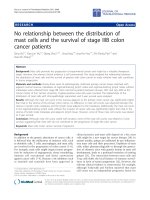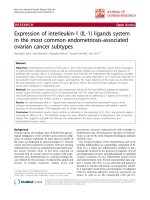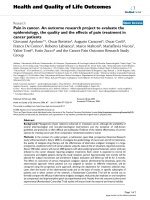Retrospective analysis of the impact of platinum dose reduction and chemotherapy delays on the outcomes of stage III ovarian cancer patients
Bạn đang xem bản rút gọn của tài liệu. Xem và tải ngay bản đầy đủ của tài liệu tại đây (760.96 KB, 8 trang )
Liutkauskiene et al. BMC Cancer (2015) 15:105
DOI 10.1186/s12885-015-1104-5
RESEARCH ARTICLE
Open Access
Retrospective analysis of the impact of platinum
dose reduction and chemotherapy delays on the
outcomes of stage III ovarian cancer patients
Sigita Liutkauskiene1*, Rasa Janciauskiene1, Kristina Jureniene2, Saulius Grizas3, Rasa Malonyte4
and Elona Juozaityte1
Abstract
Background: Ovarian cancer is a common gynaecological malignancy still remaining a challenge to treat. The
objective of this study was to evaluate the impact of platinum dose reduction and chemotherapy delays on
progression free survival and overall survival in patients with stage III ovarian cancer and to analyze reasons for such
chemotherapy scheme modifications.
Methods: Medical records of patients with FIGO stage III ovarian cancer were reviewed. Inclusion criteria involved
FIGO stage III epithelial ovarian carcinoma; cytoreductive surgery performed and 6 courses of platinum-based
chemotherapy completed; no neoadjuvant chemotherapy applied; and no history of previous malignancies.
Progression free survival and overall survival were analyzed using Kaplan-Meier and Cox proportional hazards
models.
Results: Significant 3.3 times higher death risk in patients who experienced only chemotherapy delays compared
with patients who did not experience any chemotherapy scheme modifications was established (HR = 3.3, 95% Cl:
1.2 – 8.5, p = 0.016). Increased death risk in patients who experienced only chemotherapy delays compared with
patients who experienced both chemotherapy delays and platinum dose reduction was also established (HR = 2.3,
95% Cl: 1.1 – 4.8, p = 0.021). Main reasons for chemotherapy scheme modifications (in decreasing order) were the
following: neutropenia, modifications with no objective medical reasons, renal disorders, anaemia, poor
performance status, gastrointestinal symptoms and neuropathy. Overall survival in patients who experienced
chemotherapy scheme modifications with no objective medical reasons was non-inferior than in patients who did
not experience any chemotherapy scheme modifications.
Conclusions: Chemotherapy delays in patients with FIGO stage III ovarian cancer caused lower overall survival. The
most common reason for chemotherapy scheme modifications was neutropenia.
Keywords: Ovarian cancer, Chemotherapy scheme modifications, Progression free survival, Overall survival
Background
Ovarian cancer is the fifth most common malignant
tumor in females and the forth most common cause of
female deaths from malignant tumors in the world [1].
In 2012 in Europe 65 538 new ovarian cancer cases were
diagnosed and 42 704 deaths from ovarian cancer were
registered. Meanwhile Lithuania ranks 5th among all
* Correspondence:
1
Oncology Institute of Lithuanian University of Health Sciences, Kaunas,
Lithuania
Full list of author information is available at the end of the article
European countries (incidence is 16.2 cases/100 000 females and mortality is 11.9/100 000 females) [2]. Early
diagnosis of ovarian cancer is still difficult due to absence of specific clinical signs or asymptomatic course of
the disease therefore advanced cancer is being diagnosed
in majority of patients [3]. Association between the
diameter of the postoperative residual tumor mass and
survival was first discovered by C. T. Griffths in 1975 [4]
and later proved by other studies [5,6] and these findings
were the cornerstone of the progress in ovarian cancer
treatment. Progress in treatment was also essentially
© 2015 Liutkauskiene et al.; licensee BioMed Central. This is an Open Access article distributed under the terms of the Creative
Commons Attribution License ( which permits unrestricted use, distribution, and
reproduction in any medium, provided the original work is properly credited. The Creative Commons Public Domain
Dedication waiver ( applies to the data made available in this article,
unless otherwise stated.
Liutkauskiene et al. BMC Cancer (2015) 15:105
influenced by the results of studies analyzing the effectiveness of various chemotherapy schemes carried out in
the recent decades resulting in employing platinum based adjuvant chemotherapy as main method of systemic treatment of advanced ovarian cancer [7]. Despite
the fact that disease progression after primary chemotherapy is observed in approximately two thirds of patients [8], five-year survival rate is improving from 5–
17% decades ago to 48% and more nowadays according
to some researchers [9]. According to the data of the
Nordic countries obtained during 40 years observation
period survival rates of women with ovarian cancer improved 10–15% from 1964 to 2003 [10]. Impact of
tumor stage, histology, grade and patients’ age on clinical
outcomes is well established [11,12]; however few studies
analyzed impact of chemotherapy delays and dose reduction on progression free survival and overall survival
[13]. Therefore the purpose of this study is to establish
influence of platinum dose reduction and chemotherapy
delays on progression free survival and overall survival
in women with stage III ovarian cancer and to analyze
reasons for such chemotherapy scheme modifications.
Methods
This study was approved by the Bioethics Center of
Lithuanian University of Health Sciences. Medical records of patients with International Federation of
Gynecology and Obstetrics (FIGO) stage III ovarian
cancer treated in the Afilliate of Lithuanian University
of Health Sciences Kaunas Oncology Hospital were
analyzed.
Inclusion criteria of the study were the following: 1)
patients with FIGO stage III epithelial ovarian carcinoma
diagnosed in 2004–2008; 2) cytoreductive surgery performed and 6 courses of platinum-based chemotherapy
completed; 3) medical records maintain comprehensive
data on treatment and follow-up; 4) no history of previous malignancies. Exclusion criteria were the following:
1) neoadjuvant chemotherapy applied; 2) less than 6
courses of chemotherapy or more than 6 courses of
chemotherapy completed; 3) medical records maintain
incomplete data on treatment or follow-up; 4) history of
previous malignancy.
Among all patients treated with platinum – based
chemotherapy only those who received 6 courses were
selected, because usually 6 cycles of treatment is recommended as a standard regimen; what is more this decision was taken in order to avoid possible differences in
patients outcomes influenced by unequal number of
chemotherapy cycles given.
The process of cases selection is shown in Figure 1.
The following data necessary for this study were collected: patients age at the time of diagnosis, height and
weight, tumor histology and grade, date of cytoreductive
Page 2 of 8
surgery, date of disease progression, date of last visit,
date of death. Platinum response status was evaluated
(platinum resistant tumor: disease progression occurred
within 6 months after completion of primary chemotherapy; platinum sensitive tumor: disease progression occurred after more than 6 months after completion of
primary chemotherapy). Platinum dose reduction was
defined as overall dose reduction more than 5 percent;
chemotherapy delays were defined as number of delayed
days exceeding 10 days. 5 percent as the cutoff for dose
reduction and 10 days as the cutoff for the delay were
defined because such were minimal modifications observed in our study. Reason for every single platinum
dose reduction and chemotherapy delay was established.
It should be noted that no granulocyte colony stimulating factors were administered to patients under
investigation.
Statistical analysis
The major goals of the study were to assess the impact
of platinum dose reduction and chemotherapy delays on
survival outcomes – progression free survival (PFS) and
overall survival (OS). PFS was defined as a period between the date of cytoreductive surgery and date when
tumor progression was defined or date of the last known
follow up for patients without disease progression. OS
was defined as the duration between the date of cytoreductive surgery and death, with those alive censored at
the last known follow up.
The Kaplan-Meier method was used for single variable
survival data analysis. Differences of the survival rate
were determined using the log-rank test.
Cox’s proportional hazards regression model was used
to conduct multivariate analysis. The proportional hazards assumption was examined by log (−log) plot of survival. The results are presented as medians of survival,
HR and 95% confidence intervals.
Comparison among subgroups was performed using
ANOVA for continuous covariates and Fisher’s exact test
for categorical variables.
Level of significance for statistical tests was 0.05. All
p - values presented are two – sided. The SPSS software
version 22 was used for statistical analysis.
Results
Eighty-two eligible patients were analyzed. For all patients median progression free survival was 15.4 months
(95% Cl: 9.3 - 21.4 months), and median overall survival
was 32.1 months (95% Cl: 25.5 – 38.7 months).
Patients were divided into four chemotherapy delay/
platinum reduction groups. There was no platinum dose
reduction or chemotherapy delays in 15 patients (18.3%).
In 67 patients (81.7%) chemotherapy scheme was modified: 11 patients (13.4%) experienced only platinum dose
Liutkauskiene et al. BMC Cancer (2015) 15:105
Page 3 of 8
Figure 1 Flow chart of cases used for analysis. The whole process of identification of the patients that meet study criteria is shown in this
chart. 82 patients were used for final analysis.
reduction, 12 patients (14.6%) experienced only chemotherapy delays and 44 patients (53.7%) experienced both
platinum dose reduction and chemotherapy delays.
Age at the time of diagnosis was significantly different
in these four groups (p = 0.001); other characteristics
were similar (Table 1).
The impact of patients' age, BMI, tumor grade, histology and platinum response status to overall survival
was tested conducting univariate Cox analysis. All these
variables except BMI were proved to have a possible
prognostic significance (p < 0.35) in univariate analysis
and were adopted as covariates in multivariate Cox proportional risk model. Results of this analysis for overall
survival are presented in Table 2.
This Cox proportional hazards model for overall survival with adjustment for patients’ age, tumor grade,
histology and platinum response status revealed statistically significant overall survival difference in patients
who experienced only chemotherapy delays compared
with patients who did not experience neither chemotherapy delays nor platinum dose reduction, e. g., death
risk was 3.3 times higher in patients who experienced
only chemotherapy delays compared with patients who
did not experience any modifications (HR = 3.3, 95% Cl:
1.2 – 8.5, p = 0.016). Significantly increased death risk in
patients who experienced only chemotherapy delays
compared with patients who experienced both chemotherapy delays and platinum dose reduction was also
established (HR = 2.3, 95% Cl: 1.1 – 4.8, p = 0.021).
Survival curves for overall survival adjusted for patients’ age, tumor grade, histology and platinum response status is shown in Figure 2.
According to Cox proportional hazards model for progression free survival constructed identically to abovementioned model, there were no statistically significant
differences of progression free survival between the same
four patients groups, the overall p = 0.35.
Median progression free survival and median overall
survival in these groups are presented in Table 3.
This study showed that main reasons for chemotherapy scheme modifications were the following: neutropenia (37.5%), renal disorders (15.6%), anaemia (10.9%),
Liutkauskiene et al. BMC Cancer (2015) 15:105
Page 4 of 8
Table 1 Patients groups characteristics
No platinum reduction
or delays
Platinum reduction
only
Delays only
Both Platinum
reduction and delays
(N = 15)
(N = 11)
(N = 12)
(N = 44)
Age, mean (range)
46.6 (22–67)
52.0 (42–65)
60.8 (42–82)
59.7 (40–82)
BMI, mean (range)
24.9 (16.1–46.1)
25.1 (18.2–33.7)
26.5 (19.5–39.5)
26.9 (16.7–38.2)
Serous
13 (86.6%)
11 (100%)
10 (83.4%)
32 (72.7%)
Mucinous
1 (6.7%)
0 (0%)
1 (8.3%)
4 (9.1%)
2
(kg/m )
Histology
Endometrioid
0 (0%)
0 (0%)
1 (8.3%)
1 (2.3%)
Clear cell
0 (0%)
0 (0%)
0 (0%)
2 (4.5%)
Mixed
1 (6.7%)
0 (0%)
0 (0%)
5 (11.4)
Tumor grade
Grade 1
0 (0%)
1 (9.1%)
1 (8.3%)
6 (13.6%)
Grade 2
11 (73.3%)
8 (72.7%)
9 (75.0%)
24 (54.6%)
Grade 3
4 (26.7%)
2 (18.2%)
2 (16.7%)
14 (31.8%)
(N = 82).
poor performance status (4.7%), gastrointestinal symptoms (4.7%), and neuropathy (1.6%). Modifications with
no objective medical reason accounted for 25.0%.
(Figure 3). When medical records contained no medical
reason that could predetermine platinum dose reduction
or chemotherapy delay, such modification was considered to have no objective medical reason. Considering
this reason was the second most frequent among all reasons of chemotherapy scheme modifications, overall
survival curve of patients who experienced modifications
without objective medical reasons was compared with
overall survival curve of patients who had no modifications. Using Kaplan-Meier method it was not proved
that chemotherapy scheme modifications without objective medical reason caused lower overall survival compared with patients who had no chemotherapy scheme
modifications, long-rank test p = 0.815. When chemotherapy scheme was modified with no objective medical
Table 2 Univariate and multivariate analysis of predictors for overall survival
Univariate model
Variables
Platinum response status (resistant versus sensitive)
Exp
(B)
3.412
Multivariate model
95.0% CI for Exp (B)
Lower
Upper
2.002
5.817
Chemoterapy scheme modification
p
<0.001
Exp
(B)
95.0% CI for Exp (B)
Lower
Upper
3.169
1.787
5.620
0.035
p
<0.001
0.050
No Platinum reduction or delay
1
1
Both Platinum reduction and delay
1.380
0.658
2.896
0.394
1,404
0.615
3.205
0.420
Platinum reduction only
1.388
0.550
3.500
0.487
2,054
0.755
5.586
0.159
Delay only
3.359
1.375
8.204
0.008
3.262
1.248
8,527
0.016
Tumor grade
1.386
0.908
2.115
0.130
1.547
0.936
2.556
0.089
Patients’ age
<=50
0.225
1
0.260
1
51–65
0.979
0.531
1.805
0.945
0.723
0.362
1.445
0.359
>65
1.591
0.865
2.926
0.135
1.327
0.653
2.695
0.434
1.076
0.518
2.234
0.844
1.135
4.753
histology (serous versus other)
1.393
0.706
2.750
0.339
BMI
1.012
0.973
1.053
0.539
HR
Delay only versus both reduction and delay
2.323
p
0.021
Liutkauskiene et al. BMC Cancer (2015) 15:105
Page 5 of 8
Figure 2 Overall survival: adjusted for age, tumor grade, histology and platinum response status. Cox proportional hazards model when
impact of tumor histology, grade, patients’ age and platinum response status were adjusted showed that death risk was 3.3 times higher in patients
who experienced only chemotherapy delays compared with patients who experienced no chemotherapy delays or platinum dose reduction (HR = 3.3,
95% Cl: 1.2 – 8.5, p = 0.016) and also showed that death risk was 2.3 times higher in patients who experienced only chemotherapy delays compared
with patients who experienced both chemotherapy delays and platinum dose reduction (HR = 2.3, 95% Cl: 1.1 – 4.8, p = 0.021).
reason, median progression free survival was 26.4 months
(95% Cl: 16.7 - 36.2 months) and median overall survival
was 51.2 months (95% Cl: 23.4 - 78.9 months).
Discussion
The main objective of this study was to evaluate impact
of the optimum first-line chemotherapy on clinical outcomes of patients with FIGO stage III ovarian cancer.
Although many previous studies analyzing effect of
chemotherapy schemes intensity on survival did not establish any advantages of more intense treatment compared with less intense treatment [14-16], an impact of
modifications of standard chemotherapy schemes, e.g.,
Table 3 Unajusted median progression free and overall
survival (95% Cl)
N
PFS (months)
OS (months)
No platinum
reduction or delays
15
15.4 (9.3 – 21.4)
35.8 (16.1 – 55.6)
Platinum reduction only
11
13.1 (10.7 – 34.5)
28.8 (20.5 – 37.2)
Delays only
12
10.8 (4.2 – 17.4)
15.8 (11.9–19.8)
Both Platinum reduction
and delays
44
18.3 (10.9 – 25.7)
39.6 (26.2 – 52.4)
dose reduction and chemotherapy delays, on survival
outcomes is still unclear because results of similarly designed studies are contradictory. To characterize modifications of chemotherapy schemes, the term relative dose
intensity (RDI) is also used in scientific literature; RDI is
calculated as delivered dose intensity (total delivered
dose divided by actual time required to complete therapy) divided by standard dose intensity (standard dose
divided by planned time to complete therapy). The impact of both factors forming the concept of RDI, i.e.,
dose reduction and chemotherapy delays, on survival
were analyzed in our study. C. I. Nagel et al. did not establish statistically significant survival difference between
patients who underwent modifications of chemotherapy
scheme and those that did not [13]. However J. M. Fauci
et al. in their study on the effect of RDI for the efficacy
of treatment of all stages of ovarian cancer make a conclusion that dose reduction and chemotherapy delays are
important prognostic factors for survival and these modifications should be minimized [17]. R. K. Hanna et al.
present similar results: reduced RDI exerted negative effect on overall survival of patients with stage III-IV ovarian cancer. No impact of chemotherapy scheme
modifications on progression free survival was found in
Liutkauskiene et al. BMC Cancer (2015) 15:105
Page 6 of 8
Figure 3 Reasons for chemotherapy scheme modifications. Reason for every single platinum dose reduction and chemotherapy delay was
established. The most common of them from most to least frequent were neutropenia, modifications with no objective medical reasons, renal
disorders, anaemia, poor performance status, gastrointestinal (GI) symptoms and neuropathy.
the aforementioned study by R. K. Hanna et al. [18], and
our study demonstrates the same result. It was established in our study that death risk was statistically significant 3.3 times higher (p = 0.016) in patients who
experienced only chemotherapy delays compared with
patients who did not experience any chemotherapy
scheme modifications. These results essentially confirm
conclusions of aforementioned studies carried out by J.
M. Fauci et al. and R. K. Hanna et al. concerning negative impact of chemotherapy scheme modifications on
patients overall survival. However, our study also established 2.3 times higher death risk (p = 0.021) in patients
who experienced only chemotherapy delays compared
with patients who experienced both chemotherapy delays and platinum dose reduction. This result was unexpected for us because it means that extension of the
intervals between chemotherapy courses (extends also
overall duration of chemotherapy) without dose reduction may predetermine shorter overall survival in patients with FIGO stage III ovarian cancer. Such trend
could be caused by the toxicity of chemotherapy related
to patient’s individual sensitivity to chemotherapy. This
result confirms the general principle of optimum
chemotherapy: when grade III-IV adverse reaction occurs, chemotherapeutic drugs dose must be reduced by
20–25 percent due to threatening complications or adverse reactions to chemotherapy should be managed and
treated appropriately. It should be emphasized that main
reason for chemotherapy scheme modifications in our
study was neutropenia, and colony-stimulating factors
were not administered to patients of our study. On the
other hand, similar study on RDI significance for clinical
outcomes in patients with metastatic breast cancer carried out by S. Loibl et al. also showed an unexpected
result: optimal RDI was related to shorter progression
free survival. This result was associated with early progression of the disease when disease progression or patient death occurred before 3rd course of chemotherapy.
When data of early disease progression were excluded
from the analysis, positive optimum RDI impact on
overall survival was established [19]. However, publication authors do not indicate how many patients died before 3rd course of chemotherapy and what were the
causes of deaths; these deaths could be possibly caused
by chemotherapy toxic effects. It is clear today that clinical study participants are usually patients with better
performance status without concomitant diseases or
with clinically insignificant concomitant diseases, and
therefore optimum chemotherapy treatment is administered to these patients. However, in everyday clinical
practice chemotherapy dose reduction and chemotherapy delays are frequent, and previous surgery, doctor’s
experience, adequate assessment of patients’ performance status, other treatment lines and many social factors affects clinical outcomes. It is also worth to state
that in our study in all patients who experienced chemotherapy delays total number of delayed days exceeded
10 days and this factor could contribute lower survival
as in C. I. Nigel et al. study that did not established
negative impact of delays on survival, total number of
delayed days was lower than ten days in a significant
part of patients [13].
Neutropenia was the main reason for chemotherapy delays and platinum dose reduction (37.5%). Neutropeniarelated complications often demands not only specific
treatments but also chemotherapy scheme modifications:
prospective cohort study published in 2014 showed that
60% of patients with stage IV solid tumors needed RDI
Liutkauskiene et al. BMC Cancer (2015) 15:105
reduction. Patients with stage IV ovarian cancer composed
8% of all participants of this study [20]. Eisenhauer et al.
presented the following reasons for chemotherapy scheme
modifications in patients with stage IIIC-IV ovarian cancer: myelosuppression was the main reason in patients
under 65 years, and poor performance status was the main
reason in patients over 65 years. Chemotherapy scheme
modification because of poor performance status was observed in 5.6% of all modifications made in our study [21].
Our data showed that 25.0% of chemotherapy scheme
modifications was not clinically grounded. This was specified as modification with no objective medical reason, and
this notion involves various social circumstances, transportation issues interfering patient’s admission at scheduled date, and unmotivated doctor’s decision to reduce
recommended dose. We failed to prove statistically significant negative impact of these factors on overall survival of
patients in our study.
Small subject population is limitation of this retrospective study. Possible variations of further treatment
were not taken into account and this could affect results
of patients survival. This study also had advantages: all
patients were treated in the same healthcare institution,
same methods of examination, initial treatment and
follow-up were applied and discrepancies in medical
documentation were avoided. Considering that only few
similar studies were carried out, findings of our study
are useful in clinical practice when chemotherapy
scheme individualization is necessary. Results of our
study will also be important in future: these are historical data worth to review when new systemic treatment
or surgery innovations emerge. However, larger prospective studies are needed in order to obtain more accurate and reliable results.
Conclusions
Results of our study showed that chemotherapy delays
when treating patients diagnosed with FIGO stage III
ovarian cancer were associated with lower overall survival. According to our study, the most common reason
for platinum dose reduction or chemotherapy delays was
neutropenia.
Competing interests
The authors declare that they have no competing interests.
Authors’ contributions
SL conceived of the study, participated in its coordination and wrote the
manuscript; EJ, RJ and SG participated in the study conception, data
interpretation, developing and writing of the manuscript. KJ performed
statistical analysis. RM selected cases, reviewed medical records and assisted in
writing the manuscript. All authors read and approved the final manuscript.
Acknowledgements
We greatly appreciate all the authors for their endeavor.
Page 7 of 8
Author details
1
Oncology Institute of Lithuanian University of Health Sciences, Kaunas,
Lithuania. 2Institute of Biomedical Sciences of Lithuanian University of Health
Sciences, Kaunas, Lithuania. 3Clinic of Surgery of Lithuanian University of
Health Sciences, Kaunas, Lithuania. 4Medical Academy, Faculty of Medicine,
Lithuanian University of Health Sciences, Kaunas, Lithuania.
Received: 28 November 2014 Accepted: 20 February 2015
References
1. Ledermann JA, Raja FA, Fotopoulou C, Gonzalez-Martin A, Colombo N, Sessa
C. Newly diagnosed and relapsed epithelial ovarian carcinoma: ESMO
clinical practice guidelines for diagnosis, treatment and follow-up. Ann
Oncol. 2013;24 Suppl 6:vi24–32.
2. EUCAN cancer factsheets: ovary. [ />aspx?Cancer=27&Gender=2]
3. McGuire 3rd WP, Markman M. Primary ovarian cancer chemotherapy:
current standards of care. Br J Cancer. 2003;89(Suppl3):S3–8.
4. Griffiths CT. Surgical resection of tumor bulk in the primary treatment of
ovarian carcinoma. Natl Cancer Inst Monogr. 1975;42:101–4.
5. Hoskins WJ, McGuire WP, Brady MF, Homesley HD, Creasman WT, Berman
M, et al. The effect of diameter of largest residual disease on survival after
primary cytoreductive surgery in patients with suboptimal residual epithelial
ovarian carcinoma. Am J Obstet Gynecol. 1994;170(4):974–9.
6. Bertelsen K. Tumor reduction surgery and long-term survival in advanced
ovarian cancer: a DACOVA study. Gynecol Oncol. 1990;38(2):203–9.
7. Engel J, Eckel R, Schubert-Fritschle G, Kerr J, Kuhn W, Diebold J, et al. Moderate
progress for ovarian cancer in the last 20 years: prolongation of survival, but no
improvement in the cure rate. Eur J Cancer. 2002;38(18):2435–45.
8. Ozols RF, Bundy BN, Greer BE, Fowler JM, Clarke-Pearson D, Burger RA, et al.
Phase III trial of carboplatin and paclitaxel compared with cisplatin and
paclitaxel in patients with optimally resected stage III ovarian cancer:
a gynecologic oncology group study. J Clin Oncol. 2003;21(17):3194–200.
9. Chan JK, Cheung MK, Husain A, Teng NN, West D, Whittemore AS, et al.
Patterns and progress in ovarian cancer over 14 years. Obstet Gynecol.
2006;108(3 Pt 1):521–8.
10. Klint A, Tryggvadóttir L, Bray F, Gislum M, Hakulinen T, Storm HH, et al.
Trends in the survival of patients diagnosed with cancer in female genital
organs in the Nordic countries 1964–2003 followed up to the end of 2006.
Acta Oncol. 2010;49(5):632–43.
11. Gerestein CG, Eijkemans MJ, de Jong D, van der Burg ME, Dykgraaf RH, Kooi
GS, et al. The prediction of progression-free and overall survival in women
with an advanced stage of epithelial ovarian carcinoma. BJOG.
2009;116(3):372–80.
12. Chi DS, Liao JB, Leon LF, Venkatraman ES, Hensley ML, Bhaskaran D, et al.
Identification of prognostic factors in advanced epithelial ovarian
carcinoma. Gynecol Oncol. 2001;82(3):532–7.
13. Nagel CI, Backes FJ, Hade EM, Cohn DE, Eisenhauer EL, O’Malley DM, et al.
Effect of chemotherapy delays and dose reductions on progression free and
overall survival in the treatment of epithelial ovarian cancer. Gynecol Oncol.
2012;124(2):221–4.
14. Dittrich C, Sevelda P, Salzer H, Obermair A, Speiser P, Breitenecker G, et al.
Lack of impact of platinum dose intensity on the outcome of ovarian
cancer patients. 10-year results of a prospective randomised phase III study
comparing carboplatin–cisplatin with cyclophosphamide–cisplatin. Eur J
Cancer. 2003;39(8):1129–40.
15. Jakobsen A, Bertelsen K, Andersen JE, Havsteen H, Jakobsen P, Moeller KA,
et al. Dose–effect study of carboplatin in ovarian cancer: a danish ovarian
cancer group study. J Clin Oncol. 1997;15(1):193–8.
16. Omura GA, Brady MF, Look KY, Averette HE, Delmore JE, Long HJ, et al.
Phase III trial of paclitaxel at two dose levels, the higher dose accompanied
by filgrastim at two dose levels in platinum-pretreated epithelial ovarian
cancer: an intergroup study. J Clin Oncol. 2003;21(15):2843–8.
17. Fauci JM, Whitworth JM, Schneider KE, Subramaniam A, Zhang B, Frederick
PJ, et al. Prognostic significance of the relative dose intensity of
chemotherapy in primary treatment of epithelial ovarian cancer. Gynecol
Oncol. 2011;122(3):532–5.
18. Hanna RK, Poniewierski MS, Laskey RA, Lopez MA, Shafer A, Van Le L, et al.
Predictors of reduced relative dose intensity and its relationship to mortality
Liutkauskiene et al. BMC Cancer (2015) 15:105
Page 8 of 8
in women receiving multi-agent chemotherapy for epithelial ovarian cancer.
Gynecol Oncol. 2013;129(1):74–80.
19. Loibl S, Skacel T, Nekljudova V, Lück HJ, Schwenkglenks M, Brodowicz T,
et al. Evaluating the impact of relative total dose intensity (RTDI) on
patients’ short and long-term outcome in taxane- and anthracycline-based
chemotherapy of metastatic breast cancer a pooled analysis. BMC Cancer.
2011;11:131.
20. Culakova E, Thota R, Poniewierski MS, Kuderer NM, Wogu AF, Dale DC, et al.
Patterns of chemotherapy-associated toxicity andsupportive care in US
oncology practice: a nationwide prospective cohort study. Cancer Med.
2014;3(2):434–44.
21. Eisenhauer EL, Tew WP, Levine DA, Lichtman SM, Brown CL, Aghajanian C,
et al. Response and outcomes in elderly patients with stages IIIC–IV ovarian
cancer receiving platinum-taxane chemotherapy. Gynecol Oncol.
2007;106(2):381–7.
Submit your next manuscript to BioMed Central
and take full advantage of:
• Convenient online submission
• Thorough peer review
• No space constraints or color figure charges
• Immediate publication on acceptance
• Inclusion in PubMed, CAS, Scopus and Google Scholar
• Research which is freely available for redistribution
Submit your manuscript at
www.biomedcentral.com/submit









